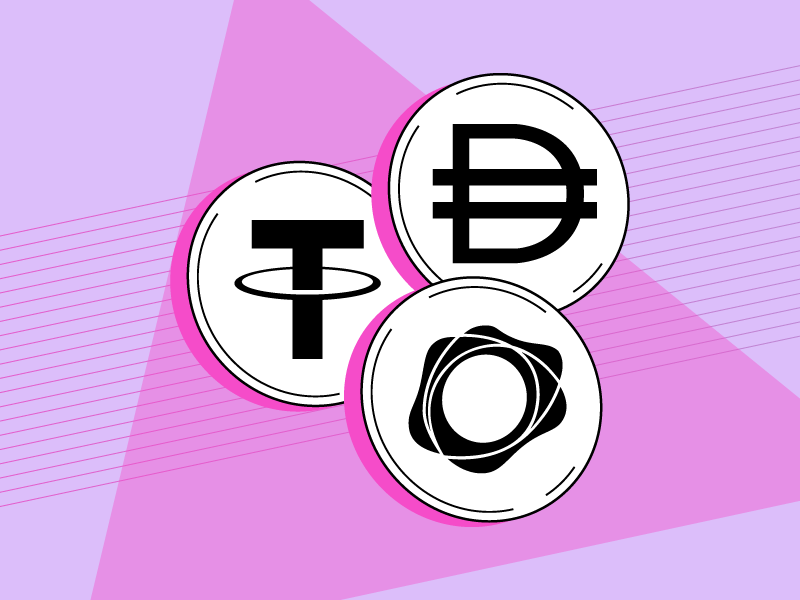What are Stablecoins? Complete Beginners Guide
By Dan Mulligan | OCT 04, 2022
4:04 Min Read
Stablecoins are cryptocurrencies where the price is pegged to another currency, commodity or financial instrument. Cryptocurrencies have, historically, been riskier investments than traditional currencies. This is largely due to their price volatility, which has made it difficult for cryptocurrencies to serve as a means for everyday transactions.
Stablecoins can potentially act as a solution for crypto’s price volatility problems. These cryptocurrencies are powered by blockchains and are tied to the value of government-backed currencies like the US dollar, precious metals such as silver or gold, or even other cryptocurrencies, such as Bitcoin.
Tether, USD Coin, Binance USD, dai, terraUSD, and other stablecoins have exploded in popularity over the last year, now boasting a combined market value of $186 billion. While stablecoins continue to grow in popularity, it’s important to understand their use cases and the underlying risks associated with them.
The Need for Stablecoins
One of the largest advantages of stablecoins are the ability to use them as a bridge between fiat and cryptocurrencies. As a result, crypto businesses routinely use stablecoins to make cash transactions, ensuring efficiency while minimizing volatility.
Stablecoins also can act as a store of value while still being able to move freely through multiple crypto ecosystems.
For instance, Stablecoins enable traders to keep their money in exchanges, protocols, and wallets while always having instant accessibility to swap them for other crypto assets.
This allows traders to avoid high fees associated with cashing out without having to hold onto a riskier asset.
While stablecoins can be inherently useful, not all stablecoins are created equally. Thus, it is important to understand the different types of stablecoins and how they work.
Types of Stablecoins
Fiat Collateralized – The most popular Stablecoins currently in circulation are backed 1:1 by fiat currency such as the US dollar, Euro, or Yen. The collateral backing these stablecoins is held with the issuer and should amount to the total value of stablecoins in circulation. For instance, a stablecoin issuer that has $100 million in fiat, can only issue up to $100 million in stablecoins, each worth $1. Some of the most popular stablecoins backed by Fiat collateral include Tether (USDT), USD Coin (USDC), and Paxos Standard (PAX).
Commodity Collateralized – commodity-backed stablecoins are pegged to the price of a physical asset like precious metals, oil, or real estate. Commodity-backed stablecoins offer the utility to exchange tokens for cash or take the position of the underlying commodity with very low maintenance costs, offering a proposition for investors to own commodities like gold and silver which have previously had high storage costs. While commodity-based stablecoins hold their value by tracking the price of commodities, they are more likely to fluctuate in price compared to fiat-backed stablecoins. Some of the commodity collateralized tokens include Paxos Gold and Tether Gold.
Crypto Collateralised – Crypto-collateralized stablecoins are essentially backed by another cryptocurrency. The process of backing occurs on the blockchain using smart contracts instead of a central issuer. To purchase a crypto backed stablecoin, a smart contract is used to lock a cryptocurrency in exchange for an equal amount of a stablecoin that represents the value. When the stablecoin is returned to the smart contract, the collateral can then be unlocked. For instance, if a user wants to mint $1,000 of DAI (DAI is the most popular crypto collateralized stablecoin), they will need to deposit between $1,500-2,000 Bitcoin (BTC / USDT) / Ethereum (ETH / USDT) (based on collateral requirements) in a stablecoin vault-like Maker DAO. When the loan is repaid and the collateral is withdrawn, DAI is then removed from the supply.
Algorithmic Stablecoins – Algorithmic stablecoins do not use fiat currency or traditional cryptocurrency as collateral. Instead of relying on collateralized assets to maintain their value, algorithmic stablecoins are buying and selling their coins on the open market. The most popular stablecoin employing this, which is Terra’s UST, uses arbitrage opportunities between UST and its LUNA token to maintain value. In the case that UST Exchange Rate rises above $1, the protocol’s stability mechanism will replace UST with LUNA. This process allows users to sell each UST on the market for more than one dollar and dilutes the UST supply—thus lowering its value to a dollar.
The Risk of Using Stablecoins
Although there are many benefits to stablecoins, there are several pitfalls of which to be aware.
Centralization Risk – Because a single company controls the centralized stablecoin, the accounts are vulnerable to theft, deactivation, and misuse. A centralized stablecoin is subject to all monetary issues that affect fiat currencies when a central authority can print money without oversight, potentially leading to hyperinflation.
Discover More
 Sorry, we can't come up with anything for your search. Please try another term.
Sorry, we can't come up with anything for your search. Please try another term.
 Back to All Posts
Back to All Posts












